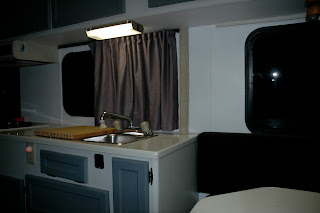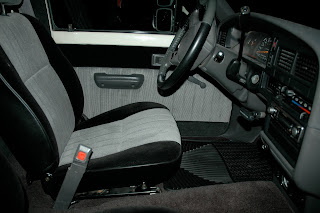After a year of using the Sunrader for point-to-point-to-point trips, we finally had the opportunity this week to give it a thorough wringing out with a three night stay at Kirk Creek, south of Big Sur on Highway 1.
Kirk Creek is listed in Sunset Magazine's top campgrounds in California, and it is by all accounts a spectacular location. The camp is set on a bluff to the west of Highway 1, with a full 180 degree view of the Pacific. The sites are mostly large with good fire rings, pedestal bbqs and picnic tables. Parking is on hardpack gravel, which is fine even on a rainy day as there is crabgrass everywhere and good drainage. Fortunately for us, the folks looking after Kirk Creek are helpful and flexible too. More on that in a bit.
Indy, our two-year-old Chocolate Lab, loved the chance to ride with a view out the front window.

We arrived late on Monday afternoon in light rain. The last 40 miles of the trip are on the coast road, which is quite windy and therefore a bit of a Dramamine proving-ground for the kids in the back. That said, all were in good spirits as we pulled in to site 17. Of all the sites, it seemed to have the steepest slope, which isn't comfortable for sleeping and can potentially wreck the refrigerator. We did our best to level the rig, and put together some franks and beans for dinner. Yep, campin'. The campground host suggested we could move in the morning, as some of the first-come-first-served sites would open up and we'd find a flat spot to settle in.
Mr. Clean Pays a Visit
I should have turned off the fridge, but instead we took Indy for a walk. When we got back, the smell of ammonia inside the Sunrader was mild. In a moment it was overwhelming. Even with all the windows open and the overhead fan full bore, there was no way to clear it out. The fridge was dead. These units use a combination of hydrogen and ammonia to cool, which means they can run on propane or electricity and operate silently. The downside is that they must be level, or the boiler can run dry and crack. I'm pretty sure that's what happened.
Anyhow, the sky had cleared up a little so we decided to sleep under the sky for the night. I rolled out the awning and put all the cushions out on a tarp -- hoping the rain had passed.
Of course, it hadn't.
At about 2:30 am, the rain started drizzling on the awning overhead and I tried to stay sleeping, hoping it would just pass on by. After all, we were right on the coast. What's a little mist? But what's the fun in that? Naw, it went from misting to dibble-dopping to pelting, and I started imagining all the nice new cushions from inside the Sunrader sopping up the Kirk Creek mud around the edges of the tarp.
So all six groggy campers (including Indy) mustered and recombobulated into the rig. Callie, in her inimitable way, managed to get in without ever disgorging herself from her sleeping bag. Fortunately, by this time, the overwhelming ammonia smell had completely dissipated and we all managed to stay dry and warm for the night.
The next morning, the campground folks helped us out and we got ourselves a nice flat site right on the edge of the bluff. Even if we'd killed the fridge, at least we'd be sleeping flat. It was a drizzly, wet day and the whole place was reminiscent of Scotland, with lots of low growing bush and groundcover and the omnipresent smell of damp. Thank goodness we weren't in a tent.
Kirk Creek
We took a quick hike down the Kirk Creek trail to the ocean. While the bluff is mostly a sheer drop to the ocean, the creek has cut a gently sloping canyon which makes for a beautiful walk through some redwoods down to the surf.
 There isn't any beach to speak of, just big gnarled rocks at the base of the cliffs. It is beautiful even in its bleakness.
There isn't any beach to speak of, just big gnarled rocks at the base of the cliffs. It is beautiful even in its bleakness.The sun came out for our final full day, and we took a longer hike up the trail on the east side of the highway, which winds up into the Ventana Wilderness section of the Los Padres National Forest. This area, just south of Big Sur, is known for its diverse plant and animal populations, with coastal, savanna, and forest environments all tightly intersecting. Big Sur, so far as I know, may be one of the few -- if only -- places where you could see a mountain lion eating a sea lion.
We hiked up through lots of chaparral on wide open hillsides, then had lunch as the trail turned into a small valley packed with tall coast redwoods. The trail goes back up, far into the wilderness and certainly warrants another trip for a longer hike or backpacking expedition.
Our last dinner at Kirk Creek was bbq next to the campfire. Even though it was beyond cold, the big fire kept us outside under the stars long enough to roast marshmallows and make S'mores. And the sunset over the pacific, with the clear winter sky framed by a distant marine layer, striped the sky with orange and gold. It made it hard to think about packing up the next morning to head home for Thanksgiving... Here are a few more shots from the trip.
-andrew












































